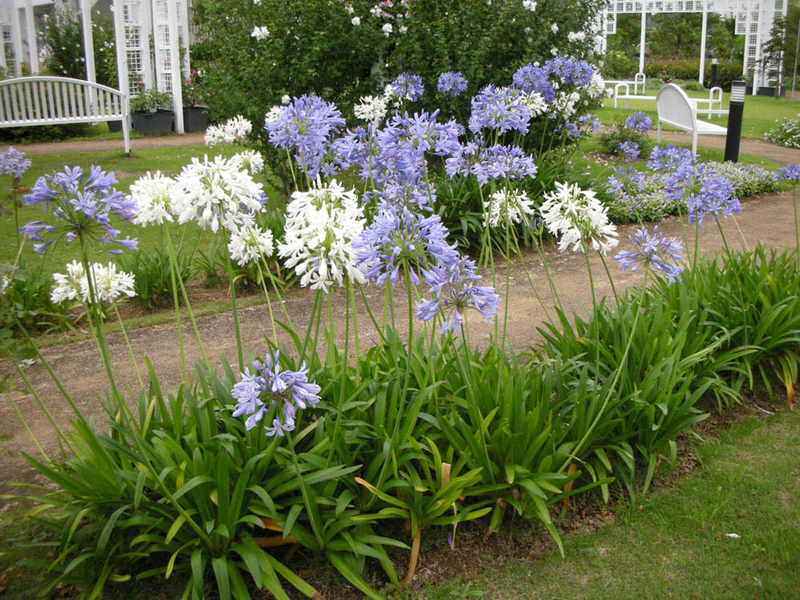Agapanthus Buddy Plants: Perfect Pairings for Your Garden
Agapanthus Buddy Plants: Perfect Pairings for Your Garden
Blog Article
Releasing the Secret to Successful Agapanthus Growing: Idea for a Flourishing Garden
In the realm of gardening, growing agapanthus efficiently requires a calculated technique that encompasses numerous aspects of plant treatment. By recognizing the nuances of agapanthus farming, one can develop an atmosphere where these plants thrive and flower generously.
Growing Agapanthus: Ideal Practices
When growing Agapanthus, correct dirt preparation is crucial for ensuring effective development and growth of these gorgeous blossoms. Agapanthus, generally known as Lily of the Nile or African lily, thrives in well-draining soil with a slightly acidic to neutral pH level - Agapanthus. Before planting, it is vital to modify hefty clay dirts with raw material such as compost or peat moss to improve drain and offer crucial nutrients for the plants
To grow Agapanthus, pick an area that obtains complete sunshine to partial shade, as this will promote healthy and balanced development and bountiful blooming. Dig an opening twice the diameter of the plant's root ball and position the Agapanthus at the same deepness it was formerly expanding. Delicately backfill the opening with dirt, pushing down securely to eliminate any type of air pockets around the roots.
Water the newly grown Agapanthus completely and continue to maintain the dirt equally damp, particularly during the plant's active expanding period. Agapanthus. Applying a balanced plant food once a month can additionally support the plant's growth and blooming. By following these ideal methods for planting Agapanthus, you can develop a sensational screen of these captivating flowers in your garden
Perfect Soil Conditions for Agapanthus
For optimal development and blooming success of Agapanthus plants, making sure the soil conditions are ideal is vital. Agapanthus likes dirt that is abundant in nutrients, so incorporating a well balanced plant food during the growing period can advertise healthy development and vibrant flowers.

Watering and Feeding Tips
To guarantee healthy and balanced development and dynamic blooms, correct watering and fertilizing methods are important for effective Agapanthus growing. Agapanthus plants benefit from regular watering, specifically throughout the growing season.
When it involves fertilizing Agapanthus, a well balanced fertilizer with equivalent parts nitrogen, phosphorus, and potassium can be used in the spring to advertise healthy growth and blooming. Slow-release plant foods are optimal for offering nutrients gradually over a prolonged duration. Prevent over-fertilizing, as this can cause extreme vegetation growth at the cost of flowers.
Additionally, incorporating natural matter like compost into the soil can boost nutrient levels and boost dirt structure, helping in helpful site the overall wellness of the Agapanthus plants. By adhering to these watering and fertilizing pointers, garden enthusiasts can ensure their Agapanthus plants prosper and create magnificent screens of flowers.
Trimming and Deadheading Strategies
Proper trimming and deadheading strategies play an important duty in maintaining the health and wellness and aesthetics of Agapanthus plants, complementing the vital practices of watering and feeding for successful growing. Trimming Agapanthus involves eliminating invested flower heads, dead or yellowing fallen leaves, and overall shaping of the plant to promote much better development. Deadheading, the process of eliminating discolored flowers, not just enhances the plant's appearance but likewise motivates more blooming.
When deadheading Agapanthus, it is a good idea to snip off the flower stem at the base utilizing sharp, tidy shears. This process redirects the plant's power from seed manufacturing back into root and foliage growth, promoting a much healthier and a lot more durable plant. Normal deadheading can expand the blooming period of Agapanthus and stop self-seeding, which can lead to overcrowding.
In regards to trimming, Agapanthus generally take advantage of a light trim after blooming to clean up the plant and urge fresh development. Cutting down the spent flower stems and eliminating any kind of damaged or dead vegetation assists preserve the plant's vigor and overall appearance. Nonetheless, it is essential to prevent reducing into the crown of the plant, as this can compromise its click this link health and wellness.

Protecting Agapanthus From Vermins and Diseases
Implementing efficient pest and condition management techniques is important to guarding the health and wellness and vigor of Agapanthus plants in cultivation. One typical pest that influences Agapanthus is the Agapanthus borer, a caterpillar that tunnels right into the plant, causing damage to the flowers and fallen leaves.
In enhancement to parasites, Agapanthus are at risk to illness such as root rot and fungal leaf areas. By remaining attentive and addressing insect and illness concerns promptly, garden enthusiasts can aid their Agapanthus prosper and thrive.

Verdict
Finally, effective farming of agapanthus requires correct planting techniques, perfect dirt conditions, ample watering and fertilizing, normal pruning and deadheading, and defense from conditions and insects. By complying with these ideas and techniques, gardeners can ensure a flourishing yard loaded with lovely agapanthus flowers. Agapanthus. Remember to preserve regular care and attention to detail to advertise the health and durability of these stunning plants
When growing Agapanthus, correct dirt prep work is important for making certain successful development and advancement of these beautiful flowers.Water the recently planted Agapanthus extensively and continue to keep the soil uniformly wet, specifically during the plant's active expanding season.For optimal growth and blooming success of Agapanthus plants, guaranteeing the dirt conditions are optimal is vital. When growing or transplanting Agapanthus, guarantee the dirt is well-prepared to supply the required structure for the this contact form plants to establish themselves successfully. One typical pest that impacts Agapanthus is the Agapanthus borer, a caterpillar that passages right into the plant, creating damage to the fallen leaves and flowers.
Report this page